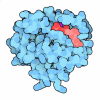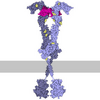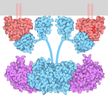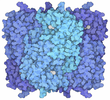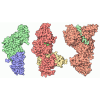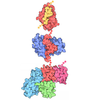登録情報 データベース : PDB / ID : 8u4iタイトル Structure of the HER4/NRG1b Homodimer Extracellular Domain Isoform 6 of Pro-neuregulin-1, membrane-bound isoform Receptor tyrosine-protein kinase erbB-4 キーワード / / 機能・相同性 分子機能 ドメイン・相同性 構成要素
/ / / / / / / / / / / / / / / / / / / / / / / / / / / / / / / / / / / / / / / / / / / / / / / / / / / / / / / / / / / / / / / / / / / / / / / / / / / / / / / / / / / / / / / / / / / / / / / / / / / / / / / / / / / / / / / / / / / / / / / / / / / / / / / / / / / / / / / / / / / / / / / / / / / / / / / / / / / / / / / / / / 生物種 Homo sapiens (ヒト)手法 / / / 解像度 : 3.38 Å データ登録者 Trenker, R. / Diwanji, D. / Bingham, T. / Verba, K.A. / Jura, N. 資金援助 組織 認可番号 国 German Research Foundation (DFG) TR 1668/1-1 National Institutes of Health/National Cancer Institute (NIH/NCI) CA274502 National Institutes of Health/National Institute of General Medical Sciences (NIH/NIGMS) GM139636
ジャーナル : Elife / 年 : 2024タイトル : Structural dynamics of the active HER4 and HER2/HER4 complexes is finely tuned by different growth factors and glycosylation.著者 : Raphael Trenker / Devan Diwanji / Tanner Bingham / Kliment A Verba / Natalia Jura / 要旨 : Human Epidermal growth factor Receptor 4 (HER4 or ERBB4) carries out essential functions in the development and maintenance of the cardiovascular and nervous systems. HER4 activation is regulated by ... Human Epidermal growth factor Receptor 4 (HER4 or ERBB4) carries out essential functions in the development and maintenance of the cardiovascular and nervous systems. HER4 activation is regulated by a diverse group of extracellular ligands including the neuregulin (NRG) family and betacellulin (BTC), which promote HER4 homodimerization or heterodimerization with other HER receptors. Important cardiovascular functions of HER4 are exerted via heterodimerization with its close homolog and orphan receptor, HER2. To date structural insights into ligand-mediated HER4 activation have been limited to crystallographic studies of HER4 ectodomain homodimers in complex with NRG1β. Here, we report cryo-EM structures of near full-length HER2/HER4 heterodimers and full-length HER4 homodimers bound to NRG1β and BTC. We show that the structures of the heterodimers bound to either ligand are nearly identical and that in both cases the HER2/HER4 heterodimer interface is less dynamic than those observed in structures of HER2/EGFR and HER2/HER3 heterodimers. In contrast, structures of full-length HER4 homodimers bound to NRG1β and BTC display more large-scale dynamics mirroring states previously reported for EGFR homodimers. Our structures also reveal the presence of multiple glycan modifications within HER4 ectodomains, modeled for the first time in HER receptors, that distinctively contribute to the stabilization of HER4 homodimer interfaces over those of HER2/HER4 heterodimers. 履歴 登録 2023年9月10日 登録サイト / 処理サイト 改定 1.0 2024年3月13日 Provider / タイプ 改定 1.1 2024年9月25日 Group / Database references / カテゴリ / citation_author / em_adminItem _citation.country / _citation.journal_abbrev ... _citation.country / _citation.journal_abbrev / _citation.journal_id_CSD / _citation.journal_id_ISSN / _citation.journal_volume / _citation.pdbx_database_id_DOI / _citation.pdbx_database_id_PubMed / _citation.title / _citation.year / _citation_author.identifier_ORCID / _em_admin.last_update 改定 1.2 2024年11月20日 Group / Structure summaryカテゴリ / pdbx_entry_details / pdbx_modification_featureItem / _pdbx_entry_details.has_protein_modification
すべて表示 表示を減らす
 データを開く
データを開く 基本情報
基本情報 要素
要素 キーワード
キーワード 機能・相同性情報
機能・相同性情報 Homo sapiens (ヒト)
Homo sapiens (ヒト) データ登録者
データ登録者 ドイツ,
ドイツ,  米国, 3件
米国, 3件  引用
引用 ジャーナル: Elife / 年: 2024
ジャーナル: Elife / 年: 2024
 構造の表示
構造の表示 Molmil
Molmil Jmol/JSmol
Jmol/JSmol ダウンロードとリンク
ダウンロードとリンク ダウンロード
ダウンロード 8u4i.cif.gz
8u4i.cif.gz PDBx/mmCIF形式
PDBx/mmCIF形式 pdb8u4i.ent.gz
pdb8u4i.ent.gz PDB形式
PDB形式 8u4i.json.gz
8u4i.json.gz PDBx/mmJSON形式
PDBx/mmJSON形式 その他のダウンロード
その他のダウンロード 8u4i_validation.pdf.gz
8u4i_validation.pdf.gz wwPDB検証レポート
wwPDB検証レポート 8u4i_full_validation.pdf.gz
8u4i_full_validation.pdf.gz 8u4i_validation.xml.gz
8u4i_validation.xml.gz 8u4i_validation.cif.gz
8u4i_validation.cif.gz https://data.pdbj.org/pub/pdb/validation_reports/u4/8u4i
https://data.pdbj.org/pub/pdb/validation_reports/u4/8u4i ftp://data.pdbj.org/pub/pdb/validation_reports/u4/8u4i
ftp://data.pdbj.org/pub/pdb/validation_reports/u4/8u4i リンク
リンク 集合体
集合体
 要素
要素 Homo sapiens (ヒト) / 遺伝子: ERBB4, HER4 / 細胞株 (発現宿主): EXPI393F / 発現宿主:
Homo sapiens (ヒト) / 遺伝子: ERBB4, HER4 / 細胞株 (発現宿主): EXPI393F / 発現宿主:  Homo sapiens (ヒト) / 参照: UniProt: Q15303, receptor protein-tyrosine kinase
Homo sapiens (ヒト) / 参照: UniProt: Q15303, receptor protein-tyrosine kinase Homo sapiens (ヒト) / 遺伝子: NRG1, GGF, HGL, HRGA, NDF, SMDF / 発現宿主:
Homo sapiens (ヒト) / 遺伝子: NRG1, GGF, HGL, HRGA, NDF, SMDF / 発現宿主: 
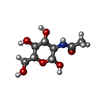
 試料調製
試料調製 Homo sapiens (ヒト)
Homo sapiens (ヒト) Homo sapiens (ヒト) / プラスミド: pCDNA
Homo sapiens (ヒト) / プラスミド: pCDNA 電子顕微鏡撮影
電子顕微鏡撮影
 FIELD EMISSION GUN / 加速電圧: 300 kV / 照射モード: FLOOD BEAM
FIELD EMISSION GUN / 加速電圧: 300 kV / 照射モード: FLOOD BEAM 解析
解析 ムービー
ムービー コントローラー
コントローラー







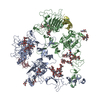

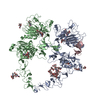
 PDBj
PDBj

